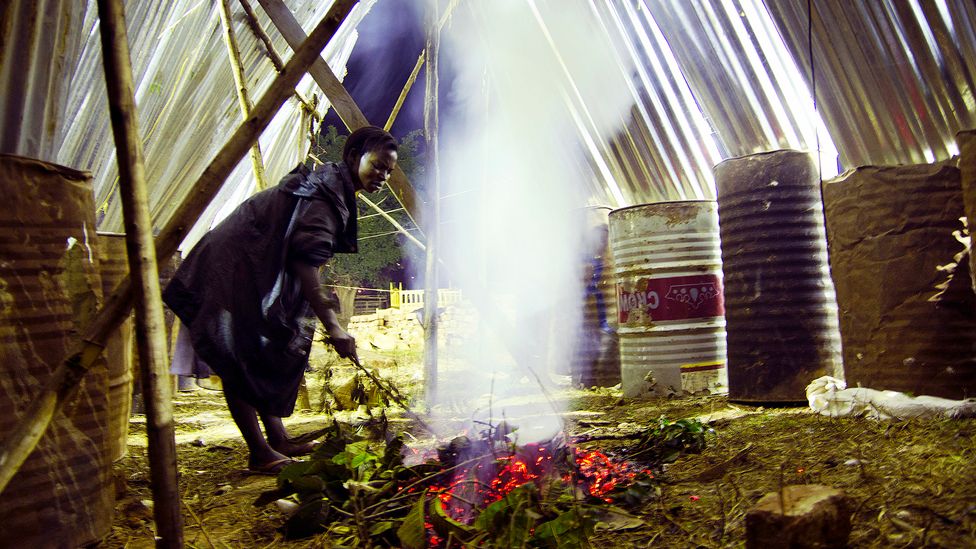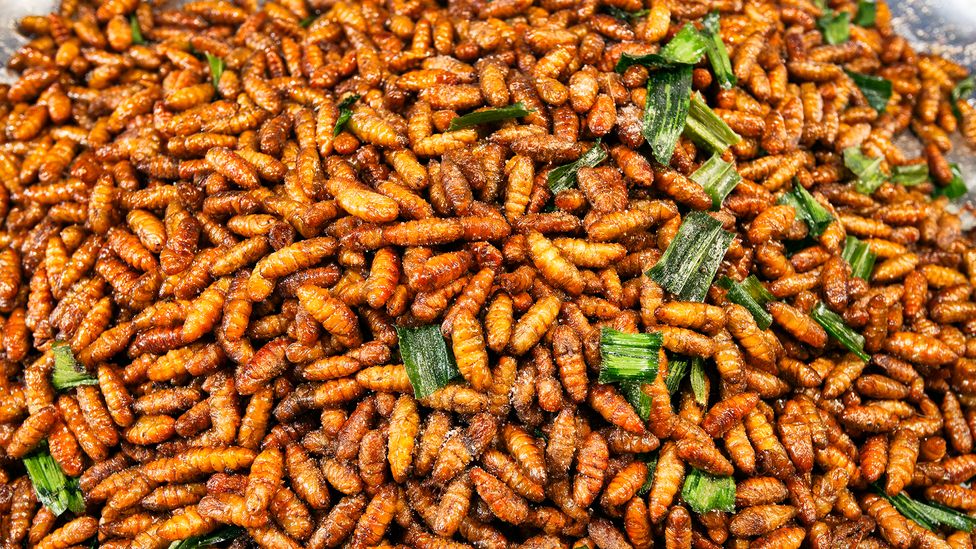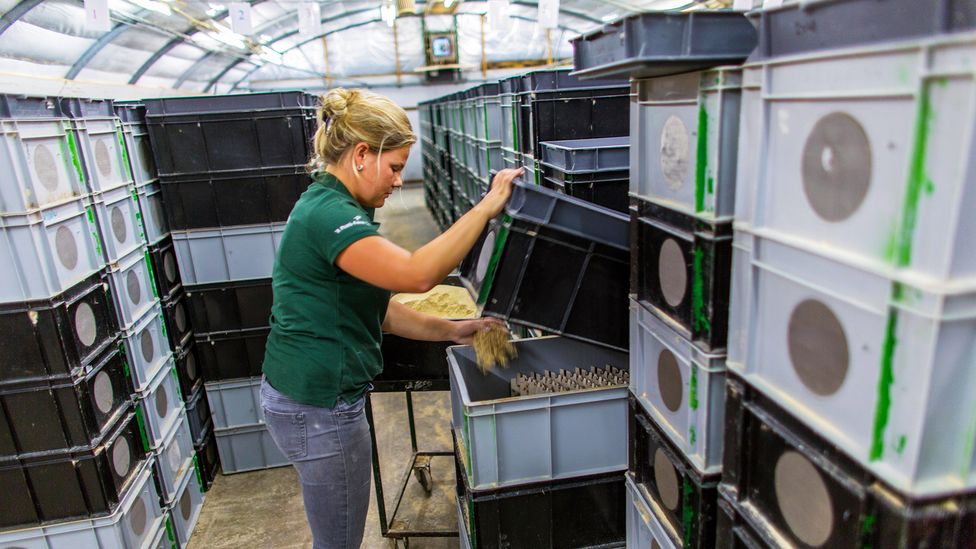The air in my family home in Uganda was filled with a distinct aroma, not dissimilar to the smell of beef being grilled. It was December 2000 and my sister, Maggie, was frying grasshoppers. The more she stirred the green, crispy locust-like insects, the stronger and richer the aroma became. As they sizzled and steam rose from the pan, my taste buds tingled – I couldn't wait to eat this delicious snack.
This wasn't my first experience of eating grasshoppers – I used to eat them regularly during my childhood. In Uganda, grasshoppers are a nutritious delicacy and a much sought-after snack.
On that occasion in 2000, I harvested the grasshoppers myself for the first time. These insects, which breed around Lake Victoria in east Africa, swarm at night and land in the dewy grass near our family home at around daybreak. On this occasion, together with my teenage peers, I spent the day picking the bugs out of the grass on a hill above my home in Hoima, western Uganda. I felt a sense of pride as I returned with a large bag full of these insects for the pot.
The smell of the grasshoppers always reminds me of Christmas – a perfect time for harvesting the insects as the seasons change from the wet of November to dry January. At Christmas, I would often choose to eat grasshoppers over beef as I preferred the taste.
Some 22 years later, in June this year, I was feeling nostalgic for this taste of home, so I decided to recreate some of my favourite grasshopper snacks. It gave me the idea for an experiment – could I swap all the meat in my diet for these crunchy critters? I had heard about the sustainability benefits of eating insects and was intrigued to find out how much I could lower my carbon footprint if I introduced grasshoppers as my main source of protein.
I now live in Kampala, Uganda's capital – a dense city without grassland where the grasshoppers can land. During Uganda's two grasshopper seasons, – May-June and December-January – when the insects swarm in massive numbers across Africa's grasslands and open bushes, Kampala's residents rely on vendors to supply these tasty bugs. The vendors use bright electric lights to lure the grasshoppers and trap them. They burn fresh grass, using the smoke to make the insects dizzy, causing them to fly into iron sheets and fall into empty oil drums.

In Uganda's capital city, Kampala, street vendors use bright lights and smoke to catch grasshoppers (Credit: Michele Sibion/Getty Images)
The grasshopper trade is a booming business. Every season the streets of Kampala crawl with vendors, who can earn around 760,000 Ugandan Shillings (USh), or about $200/£162, per season. For one plastic cup full of live grasshoppers, with their wings and legs plucked off, I pay 20,000Ush ($5.26/£4.40).
When I return home, I wash the insects in a bowl and place them in a dry pan, covering it and putting it over a low flame for around 20 minutes, occasionally stirring to ensure the insects don't burn.
About an hour later, the grasshoppers start to sizzle and their colour changes from green to yellow as they yielded fat, allowing me to fry them without cooking oil. At this point, the beefy aroma starts to emerge, growing stronger as I stir every five minutes or so until their colour turns a golden brown. I then add onions, hot pepper and salt.
The insects continue frying until the fat dissolved, and the bugs start to sound crunchy as they hit the pan as I stir. After another 30 minutes, the grasshoppers develop a crunchy texture like crisps and are ready to eat.
The beauty of grasshoppers is that you can eat them with many types of food in the same way you would eat chicken wings with French fries. Over the four days of my experiment, I ate grasshoppers with cassava, potatoes, rice and cowpeas stew.
A cup of grasshoppers is slightly more expensive than a kilogram (2.2lbs) of beef, which goes for around 13,000USh (£2.86/$3.42). However, with only one cup of grasshoppers, I made three meals.
On the second day, I had grasshoppers and potatoes, which I normally eat with meat or bean stew. On the third and fourth day, I paired the grasshoppers with rice and cowpeas stew.
To me, grasshoppers are like popcorn – a snack that I never want to stop eating and don't get bored of. While I personally find beef starts to taste bland if I eat it too often, my appetite for grasshoppers didn't wane, even after eating it four days in a row. The only challenge, though, is that my jaws started to hurt a little on the third day, from biting into the crunchy bugs all week. Another downside was that the salty grasshoppers' left me feeling incredibly thirsty.
It took longer than I had anticipated to prepare grasshoppers, which made me realise how much effort and time my sisters used to put into this process. But cooking them is not a complicated or demanding task – I often read a book while waiting for them to cook. While I used onions and hot pepper to fry them, extra ingredients aren't necessary as the grasshoppers are delicious in themselves.
Sustainable protein
Grasshoppers are a protein-rich and sustainable snack. They play an important role in improving nutrition, food security and employment in east Africa, says Leonard Alfonce, a researcher in entomology at Sokoine University of Tanzania, who believes the insects should be cultivated as a sustainable food source throughout the year.
"The edible grasshoppers are highly valued and their trading is a source of income in Uganda," Alfonce says. "Optimising mass rearing protocols for edible grasshoppers would ensure their year-round supply to enhance nutrition, food security, and livelihoods in East Africa."
In terms of nutritional content, the long-horned grasshoppers, known as Nsenene in Uganda, constitute 34-45% protein, 42-54% fat and 4-6% fibre. Insects generally are packed with vitamins and amino acids.
Then there are the sustainability benefits. Insect cultivation uses a fraction of the land, energy and water required for traditional farming, and has a significantly lower carbon footprint. (Watch our video on how insects are the missing link in our food chain on BBC Reel.)
Peter Alexander, a senior researcher in global food security at the University of Edinburgh, in the UK, estimates that I might have reduced the carbon emissions from my diet by a factor of ten by substituting beef for grasshoppers as my main source of protein. "What we choose to eat really matters for the emissions associated with our diets," he says.
Replacing half of the meat eaten worldwide with mealworms and crickets could reduce farmland use by a third, freeing up 1,680 million hectares, equivalent to around 70 times the area of the UK, and reducing global emissions, according to a study by Alexander and other researchers at the University of Edinburgh.
Insects also have a high food conversation rate – for instance crickets need six times less feed than cattle, four times less than sheep and two times less than pigs and chickens to produce the same amount of protein.
Cultivating insects produces significantly fewer greenhouse gases than livestock production – especially when you consider the transport of livestock and feeds which accounts for 18% of these emissions.
Crickets, for example, produce up to 80% less methane than cows and 8-12 times less ammonia than pigs, according to a study by researchers at the University of Wageningen in the Netherlands. Methane is a highly potent gas with a global warming impact 84 times higher than CO2 over a 20-year period and ammonia pollution has been linked to soil acidification, groundwater pollution and ecosystem damage.
Insects can also eat organic waste, helping to reduce the emissions that occur as this waste rots, and also reducing the overall emissions per kg of food more generally.
"I agree the emission intensities for many protein-rich insects are many times lower than any animal-based food," says Atul Jain, a researcher who specialises in climate change's impact on agriculture and food supply at the University of Illinois Urbana-Champaign in the US. "But they are not produced at the industrial level, like beef or any other food commodity. So, it will not be a fair comparison of the greenhouse gas emissions for any diet, plant-based or animal-based."
But given all their benefits, could insects be farmed more widely?
"Insects are easy to raise compared to animals. You can have an insect farm in the basement and in your house and you will have a million insects in a few days," says Bill Broadbent, the president of Entosense, a US company on a mission to make edible insects part of Americans' daily diet.
While insects might not replace meat altogether, they represent a significant alternative protein source in a world likely to struggle with food scarcity over the coming years as the global population continues to grow, says Broadbent.

In many parts of Asia and Africa, insects are fried and sold as a popular snack (Credit: Bob Henry/Getty Images)
For instance, for every kg of high-quality animal protein produced, livestock are fed around 6kg of plant protein. It's estimated that an increase in agricultural costs, such as fertiliser and animal feed, will result in a rise of over 30% in prices for beef, pork and poultry by 2050. It's also thought that these prices might increase by an additional 18-21% due to climate change and falling agricultural productivity, which will drive up feed costs, amplifying the need for alternative protein sources.
Growing demand for edible insects
Around 2,000 insect species are eaten worldwide in countries across Africa, South America and Asia. Thailand has a particularly thriving insect industry, with 20,000 farms producing 7,500 tonnes of bugs per year. But many people in Europe and the US are still hesitant to eat insects despite their excellent taste and environmental and nutritional benefits, missing an opportunity to reduce the carbon footprint of their diets.
While living in the UK between 2019 and 2021, I struggled to buy edible grasshoppers. In December 2021, I was craving grasshoppers after seeing images of this tasty snack all over my social media feeds, shared by Ugandan friends celebrating the start of the grasshopper season. My search for the Ugandan delicacy took me to east and west London and Leeds, but I couldn't find any.
Indroneel Chatterjee, a researcher in consumer psychology and marketing at Oxford Brookes University, in the UK, says people looking for edible insects in the UK should start with crickets and mealworms, which are more readily available than grasshoppers. "There may be supply chain issues that restrict [the] availability [of grasshoppers] as they aren't currently mass produced in the UK, making them difficult to procure," says Chatterjee.
There are also concerns that widespread wild harvesting of insects in some countries could only place more pressure on declining of insect populations already threatened by changing climate, disease and pesticides.
There are, however, a growing number of companies in Europe and the US that specialise in raising edible insects. Located in St Davids in Wales, Bug Farm, the UK's first edible insect farm, sells a wide range of insect snacks, including chocolate cookies made from crickets and spiced orange and laverbread buffalo insect biscuits. It also sells cricket powder and whole crickets for cooking and baking at home.
Bug Farm believes encouraging children to try insects could increase their appeal. "Children, in particular, are very open minded, so we believe that working with them is how we can change attitudes in the long term: they are the shoppers of the future," says Elinor Philp who works at Bug Farm.
Bug Farm has developed a new type of food, VEXo, made with insect and plant protein and they served it in bolognese to 200 Welsh school children during a pilot project in 2019. Before trying VEXo, 27% of the pupils said they would pick it for school lunch, but after tasting it, 56% said they would choose it.
"We strongly believe that, if young people have learned about edible insects and VEXo, when they start buying for their families in years to come, they will say: 'Oh yeah, insects: they're just another type of food'," Philp says.
Bug Farm says grinding dried insects into power and including them in dishes is one of the best ways of appealing to people who are hesitant about eating bugs.
Aly Moore, who is popularising edible insects through her blog Bugible, says she uses cricket powder in her breakfast protein shake every morning. "It's the best for protein bioavailability, other nutrients, sustainability, and it's non-bloating," she says. "I cannot recommend it more highly."
Moore, who is the chief communications officer at Chapul Farms – a company involved in building and operating insect farms in the US, tried grasshoppers for the first time on a trip to Mexico in 2012.
"I was curious and decided to try them out. It turned out they were delicious and that changed my life forever," she says. "I am [now] working full time with bugs."
She is hopeful that insect eating will catch on in Europe and the US. "There is a lot of research going on and the insect industry is experiencing rapid growth," she says.
Attitudes are already shifting and demand for edible insects is growing – by 2027, the edible insects market is projected to reach $4.63bn (£3.36bn).
Edible insects are no longer only sold by specialist stores, but stocked by European supermarket chains including Carrefour and Sainsbury's while cricket milkshakes feature on the menu of US fast food chain Wayback Burgers.

If insects are to replace beef and other meats, they will need to be intensively farmed like at this facility in the Netherlands (Credit: Ton Koene/Alamy)
But even if you don't plan to buy edible insects soon, you may already be eating them. They can inadvertently find their way into their food, either by being caught up in fresh produce we eat or accidentally mixed into products such as pasta, cakes and bread. The Food and Drug Administration in the US even has tolerances for how much insect contamination it will allow in food before it has to be withdrawn. A 100g (3.6oz) bar of chocolate, for example, can contain up to 60 insect fragments (parts of insects rather than a whole body) before the FDA takes regulatory action. Wheat flour can have up to 75 insect parts in every 50g (1.8oz), while macaroni and noodles can have up to 225 insect parts for every 225g (8oz).
"It is just not worth the energy to remove every fragment of insect when harvesting crops," says Philp.
It is also worth noting that some species of fig rely upon pollination by a specialised fig wasp, which lays its eggs inside the fruit before dying inside the fruit. But the wasp's body is quickly digested by an enzyme ficin, which is produced by the fig, effectively leaving little of the wasp behind. This has still led to debates among some vegans about whether they can eat the fruit. The crunchy texture inside a fig, however, is not caused by wasp body parts but instead by seeds. Most figs sold in modern supermarkets are pollinated without wasps at all.
But even putting this incidental ingestion to one side, many scientists believe the widespread squeamishness over eating insects may need to change if the world hopes to meet its twin goals of providing more nutritious food for everyone with a lower environmental impact.
In the meantime, I am looking forward to the next grasshopper season so I can enjoy my favourite snack.
--
Join one million Future fans by liking us on Facebook, or follow us on Twitter or Instagram.
If you liked this story, sign up for the weekly bbc.com features newsletter, called "The Essential List" – a handpicked selection of stories from BBC Future, Culture, Worklife, Travel and Reel delivered to your inbox every Friday.
Why I prefer eating grasshoppers to beef - BBC
Read More

No comments:
Post a Comment